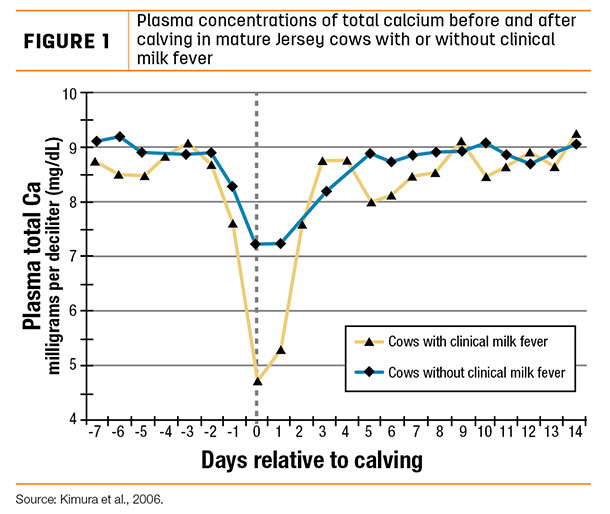What have we learned in the last five years? In this first of a two-part series, the authors detail the challenge of subclinical hypocalcemia. Click here to read part-two in this series Optimal preventio of hypocalcemia. Approximately five years ago, we published an article in Progressive Dairyman (October 12, 2011) in which we discussed how hypocalcemia is an important determinant of fresh cow health and productivity.
Since that time, we have learned a great deal more about this common metabolic disease through published clinical research, field trials and on-farm experiences. Here are five key points that can help you better manage hypocalcemia on your dairy.
- Subclinical hypocalcemia (SCH) is extremely common in dairy herds.
- Higher-producing and older cows are more susceptible to SCH.
- Some drop in blood calcium concentration is necessary for cows to respond to the calcium drain at the start of lactation.
- High-producing cows and lame cows have the best economic return to oral calcium supplementation post-calving.
- Optimal management of hypocalcemia requires using both dietary manipulation pre-calving and oral calcium supplementation post-calving.
Prevalence of subclinical hypocalcemia
The start of each new lactation really challenges a dairy cow’s ability to maintain normal blood calcium concentrations. Milk (including colostrum) is very rich in calcium, and cows must quickly shift their priorities to adjust for this sudden calcium outflow.
Average blood calcium concentrations noticeably decline in second-or-greater-lactation cows around calving; most cows drop below normal blood calcium concentrations around this time frame. This is illustrated in Figure 1.
 Subclinical hypocalcemia is defined as low blood calcium concentrations without obvious clinical signs. A cow does not necessarily have to become recumbent (down) to be negatively affected by hypocalcemia.
Subclinical hypocalcemia is defined as low blood calcium concentrations without obvious clinical signs. A cow does not necessarily have to become recumbent (down) to be negatively affected by hypocalcemia.
Although we cannot see how much SCH is present within a herd, we can measure it by drawing and testing blood from approximately 20 cows post-calving. This blood sample should ideally be collected 12 to 24 hours after calving, when cows typically experience their low point in blood calcium concentrations.
It makes sense that cows reach their low point in blood calcium the day after calving, because they have lost calcium from one or two milkings of colostrum and transition milk during this time frame.
Because cows are usually locked up just once daily, collection of the samples needed for blood calcium analysis can fit within the normal management activities of large dairies.
The negative consequences of SCH include reduced milk yield, immune suppression, higher concentrations of blood nonesterified fatty acids, increased risk for other metabolic diseases, increased risk for metritis, increased risk for coliform mastitis and increased risk for early removal from the herd.
The exact point in blood calcium concentration at which negative consequences start is termed the cutpoint.
Several different cutpoints for SCH have been proposed. Different studies use different measures and involve different on-farm conditions. Therefore, we do not expect cutpoints to be the same from one study to the next. Reported cutpoints for SCH include 8.6 milligrams per deciliter (mg/dL), 8.4 mg/dL and 8.0 mg/dL.
Subclinical hypocalcemia is pervasive in today’s dairy herds. Our recent field studies show the prevalence (total number of cases at a point in time) of SCH is about 60 percent in second-and-greater- lactation cows using the 8.6 mg/dL cutpoint, about 50 percent using the 8.4 mg/dL cutpoint and about 35 percent if the 8.0 mg/dL cutpoint is used.
A large field study conducted in 2011 reported 46 percent SCH in second-and-greater-lactation cows at the 8.0 mg/dL cutpoint.
Your management of hypocalcemia is excellent if your herd is well below the SCH prevalence ranges described above. If not, then consider preventive measures, which will be outlined in the second article in this series.
Preventing clinical milk fever cases alone is not an adequate measure of the hypocalcemia management within a herd. Low clinical milk fever rates often mask an underlying SCH problem. The main manifestation of hypocalcemia in dairy herds today is SCH rather than clinical milk fever. Preventive programs should focus on minimizing the impact of SCH, the target disease, as much as possible.
Higher-producing and older cows at increased risk
The more data we collect from field trials, the more apparent it becomes that higher-producing cows and older cows within herds experience the most SCH. Improving transition cow management increases the longevity of dairy cows; this ultimately increases herd milk yield and profitability. However, older cows are at higher risk for SCH.
Increases in genetic progress, fueled by recent advances in genomic testing, are increasing milk yields faster than ever. However, high milk production (independent of age) also raises the risk for SCH. Thus, the better the herd’s management, the more important it becomes to proactively address this hidden disease problem.
Reduced blood calcium is necessary at lactation start
When a cow’s blood calcium declines around calving, she responds by secreting parathyroid hormone (PTH) into the bloodstream. This hormone increases the mobilization of calcium from bone into blood, increases intestinal absorption of calcium and decreases urinary excretion of calcium.
Mobilization of bone calcium is termed lactational osteoporosis, and almost all cows experience this in the first few months after calving. Remarkably, a cow loses about 9 to 13 percent of her skeletal calcium in the first month of lactation. The cow restores this lost calcium to her skeleton later in lactation.
In the short term, this stresses the cow’s bones, but in the long term it allows her to maintain normal blood calcium concentrations.
This essential process is initiated by a sufficient reduction in blood calcium concentration to stimulate PTH release. However, this decline in blood calcium should not be too profound nor should it last too long.
Otherwise, the negative cascade of events that result from SCH will negatively affect cow health and production.
References omitted but are available upon request. Click here to email an editor.
—Submitted by Boehringer Ingelheim Vetmedica






